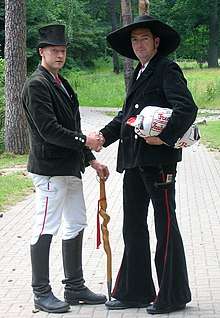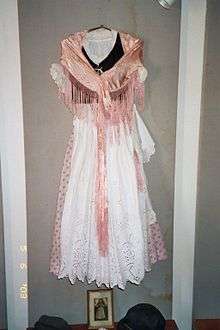Tracht
Tracht (German pronunciation: [ˈtʁaxt]) refers to traditional garments in German-speaking countries and regions. Although the word is most often associated with Bavarian, Austrian, South Tyrolian and Trentino garments, including lederhosen and dirndls, many other German-speaking peoples have them, as did the former Danube Swabian populations of Central Europe.


Descriptions of different tracht customs
In northern Germany some of the best known examples are the "Friesische Tracht" and the Finkenwerder Tracht. The "Friesische Tracht" is richly decorated with beads and embroidery. The quality of the work was a sign of the riches and social status of the wives wearing it. In former times it was brought into a marriage by the bride as part of her dowry. This costume is occasionally still worn at weddings. The "Finkenwerder Tracht" is the traditional garment of the inhabitants of an island in the Elbe river. It is worn by a local folklore group called Finkwarder Speeldeel.
Visitors to the Black Forest region will be familiar with the wide brim hats decorated with big red pompons (known as Bollenhut) that are part of the Tracht in the three villages of Kirnbach, Gutach and Reichenbach.
Displaced German peoples like the Sudetendeutsche often used events where they wore Tracht to emphasize their unity.
Costumes worn by professional guilds, habits of religious orders, deaconesses, and the historical garment of some occupational groups (e.g. nurses) are also called "Tracht". While some of them have fallen into disuse, carpenter journeymen can still be seen wearing their traditional garment while traveling throughout Europe.
History
Folk costumes originated in rural areas. They showed that the wearer belonged to a particular social class, occupation, religious persuasion or ethnic group. In the country, the folk costumes developed differently from one another. They were influenced by urban fashions, costumes in neighbouring regions, available materials, as well as fashions in the royal courts and in the military. The earliest known folk costumes developed at the end of the 15th century. Although folk costumes varied in practice between everyday and festive versions, the festive version of each costume tradition was considered the ideal form.
The history of tracht in the 19th century is inseparable from the history of the movement in German-speaking countries to promote folk costume (Trachtenbewegung). The idea of an approved folk costume dates back to the 18th century, and was promoted by the Swedish king Gustav III.[1] At the beginning of the 19th century, enthusiasm for the different costumes of the rural population developed at the royal courts of Bavaria and Austria.[2] The interest in traditional costume was part of a wider cultural response to the humiliations suffered through the repeated foreign invasions during the Napoleonic Wars. The German-speaking peoples investigated their cultural heritage as a reaffirmation of their identity. The result was a flowering of research and artistic work centred around Germanic cultural traditions, expressed in painting, literature, architecture, music and promotion of German language and folklore.[3]
The first extensive description of traditional tracht in the different regions was given by the Bavarian official Joseph von Hazzi (1768–1845). A comprehensive description of Bavarian national costumes was published in 1830 by the archivist Felix Joseph von Lipowsky. A parade of traditional costumes took place in 1835 at Oktoberfest, to celebrate the silver wedding anniversary of King Ludwig I of Bavaria and Queen Therese. Under his successor Maximilian II, traditional costumes were officially recognised as clothing suitable for wearing at the royal court. The king himself included officials wearing tracht in his court ceremonies and wrote in 1849 that he considered the wearing of traditional dress of "great importance" for national sentiment.[4]
In 1859, the first association to promote traditional costume was founded in Miesbach in Bavaria. In the following years, similar tracht associations (Trachtenvereine) were founded throughout Germany and Austria. The first umbrella organisation for the tracht associations was founded in 1890.[2][4] In 1895, the Bavarian novelist Maximilian Schmidt organized a parade of traditional costume at Oktoberfest, with 1,400 participants in 150 traditional costume groups.[5]
Other uses
Originally, the word "Tracht" had a much wider meaning in German in the sense of "what is carried/worn/borne", as it is connected to the verb "tragen", meaning "to carry/wear/bear". So "Tracht" can refer to the clothes which are worn, but e.g. also simply to a load, which is carried (still used by beekeepers, referring to the load of honey carried in by the bees), or within the German idiom "eine Tracht Prügel" (a load (of) beating) to "a good beating".
- Frisian Tracht from the North Sea isle of Föhr
 Tracht from South Tyrol
Tracht from South Tyrol Carpenter in Zimmermannstracht on the right
Carpenter in Zimmermannstracht on the right Danube Swabian women's tracht from Romanian Banat
Danube Swabian women's tracht from Romanian Banat
See also
- Austrian folk dancing
- British country clothing
- Dirndl
- Haferlschuh
- Lederhosen
- National costume
References
- Gustav III: Circulaire Til Prästerskapet Uti Linköpings Wällofliga Stift, Rörande en stadgad nationel Kläde-drägts antagande, aldeles skild ifrån Främmande. Den 18. Martii 1778. Nr. 132. Linköping 1778.
- Lipp, Franz C., Elisabeth Längle, Gexi Tostmann, Franz Hubmann (eds.): Tracht in Österreich. Geschichte und Gegenwart. Brandstätter, Vienna, 1984, ISBN 3-85447-028-2.
- Neil MacGregor, Germany: Memories of a nation, Penguin, London, 2016, pp. 112-130. ISBN 978-0-141-97978-6
- Vereinigte Bayerische Trachtenverbände (ed.): Bayrisch Land, bayrisch Gwand, geschichtlicher Beitrag zur Trachten- und Heimatpflege in Bayern, anläßlich des 50. Gründungstages der Vereinigten Bayerischen Trachtenverbände. Chiemgauer Verlagshaus – Eigenverlag Vereinigte Bayerische Trachtenverbände, Traunstein 1976, OCLC 140201858.
- Schmidt, Maximilian (1902). Meine Wanderung durch 70 Jahre. Part Two [Zweiter Teil] (in German). Reutlingen: Enßlin & Laiblin. pp. 93–98.
External resources
| Wikimedia Commons has media related to Tracht. |
Further reading
- Viktor von Geramb and Konrad Mautner: Steirisches Trachtenbuch. Leuschner & Lubensky, Graz 1935
- Franz C. Lipp: Oberösterreichische Trachten, volumes 1–5.
- Franz C. Lipp, Elisabeth Längle, Gexi Tostmann, Franz Hubmann (eds.): Tracht in Österreich. Geschichte und Gegenwart. Brandstätter, Vienna, 1984, ISBN 3-85447-028-2. (in German)
- Hilde Seidl: Niederösterreichische Trachten. One of the most comprehensive works about Lower Austrian costumes.
- Christl Schäfer, Hannelore Rosenberger: Trachten aus und rund um Wien. Ein Werkbuch (mit Schnittmusterbogen). Leopold Stocker publishing house. ISBN 3-7020-0500-5
- Monika Ständecke: Bandlhut und Bauchgurt: Trachtengeschichte(n) aus dem Priental; Illustrierte zur Sonderausstellung "Leibhemd und Gichtersegen" im Müllner-Peter-Museum Sachrang, 1. Mai bis 31. Oktober 2008. Müllner-Peter-Museum, Sachrang 2009.